The Determination of the Methane Content of Coal Seams Based on Drill Cutting and Core Samples from Coal Mine Roadway
Abstract
:1. Introduction
2. Background
3. Materials and Methods
3.1. Collection of Coal Samples for Testing
3.2. Methodology for the Determination Methane Content of Coal
4. Results and Discussion
5. Conclusions
Author Contributions
Funding
Institutional Review Board Statement
Informed Consent Statement
Data Availability Statement
Conflicts of Interest
Nomenclature
| the ash content in coal, % | |
| the methane concentration in the gas mixture obtained by degasifying the sample, cm3 | |
| the methane concentration in the mine excavation, % | |
| the content of dry-ash-free coal in the sample, % | |
| the total moisture content in coal, % | |
| coal density, g/cm3 | |
| the methane content of coal, m3/tdaf | |
| the mass of the coal sample, g | |
| the methane content of coal determined for core sample, m3/tdaf | |
| the methane content of coal determined for drill cuttings sample, m3/tdaf | |
| the mass of dry-ash-free coal, g | |
| the methane content of the coal determined in the laboratory, m3/tdaf | |
| the pressure of the gas mixture obtained by degasifying the sample in the measuring tank, hPa | |
| the atmospheric pressure in the mine excavation, hPa | |
| the reference pressure ( = 1013.25 hPa), hPa | |
| the saturation pressure during sorption measurements, MPa | |
| the air temperature in the mine excavation, °C | |
| the temperature of the air in the laboratory, °C | |
| the reference temperature ( = 20 °C), °C | |
| the volume of the balls in the steel canister, cm3 | |
| the volume of the methane obtained from the coal sample, cm3 | |
| the volume of the methane in the gas mixture obtained by degasifying the sample, cm3 | |
| the volume of methane in the air taken to steel canister in the mine, cm3 | |
| the volume of the coal sample, cm3 | |
| the volume of the remaining space in the steel canister with the coal sample, cm3 | |
| the volume of the gas mixture taken to the steel canister with the coal sample during the collection of the sample with reference to the on-site conditions, cm3 | |
| the volume of the gas mixture obtained by degasifying the sample with reference to the on-site conditions, cm3 | |
| the volume of the measuring canister, cm3 | |
| the volume of the steel canister, cm3 |
References
- Szlązak, N.; Obracaj, D.; Korzec, M. Estimation of Gas Loss in Methodology for Determining Methane Content of Coal Seams. Energies 2021, 14, 982. [Google Scholar] [CrossRef]
- Polish Committee for Standardization PN-G-44200:2013-10; Górnictwo—Oznaczanie Metanonośności w Pokładach Węgla Kamiennego—Metoda Zwiercinowa. The Polish Committee for Standardization: Warszawa, Poland, 2013. (In Polish)
- Szlązak, N.; Obracaj, D.; Korzec, M. Method for determining the coalbed methane content with determination the uncertainty of measurements. Arch. Min. Sci. 2016, 61, 443–456. [Google Scholar] [CrossRef] [Green Version]
- Creedy, D. Methods for the evaluation of seam gas content from measurements on coal samples. Min. Sci. Technol. 1986, 3, 141–160. [Google Scholar] [CrossRef]
- Seidle, J. Fundamentals of Coalbed Methane Reservoir Engineering; PennWell Corporation: Tulsa, OK, USA, 2011. [Google Scholar]
- Saghafi, A. Discussion on determination of gas content of coal and uncertainties of measurement. Int. J. Min. Sci. Technol. 2017, 27, 741–748. [Google Scholar] [CrossRef]
- Nazimko, V. A method for measuring coalbed methane content in coal strata without the loss of the gas. Acta Geodyn. Geomater. 2018, 15, 379–393. [Google Scholar] [CrossRef] [Green Version]
- Liu, Y.; Dua, Y.; Li, Z.; Zhao, F.; Zuo, W.; Wei, J.; Mitri, H. A rapid and accurate direct measurement method of underground coal seam gas content based on dynamic diffusion theory. Int. J. Min. Sci. Technol. 2020, 30, 799–810. [Google Scholar] [CrossRef]
- Bertard, C.; Bruyet, B.; Gunther, J. Determination of desorbable gas concentration of coal (direct method). Int. J. Rock Mech. Min. Sci. Géoméch. 1970, 7, 43–65. [Google Scholar] [CrossRef]
- Smith, D.M.; Williams, F.L. A new technique for determining the methane content of coal. In Proceedings of the 16th Intersociety Energy Conversion Engineering Conference, American Society of Mechanical Engineers, Atlanta, GA, USA, 9–14 August 1981; pp. 1272–1277. [Google Scholar]
- Diamond, W.P.; Schatzel, S.J. Measuring the gas content of coal: A review. Int. J. Coal Geol. 1998, 35, 311–331. [Google Scholar] [CrossRef]
- Kissell, F.N.; McCulloch, C.M.; Elder, C.H. The Direct Method of Determining Methane Content of Coalbeds for Ventilation Design; Report of Investigations 7767; United States Department of the Interior, Bureau of Mines: Washington, DC, USA, 1973.
- Schatzel, S.J.; Hyman, D.M.; Sainato, A.; LaScola, J.C. Methane Contents of Oil Shale from the Piceance Basin, CO; United States Department of the Interior, Bureau of Mines, Report of Investigations; Paper 9063; United States Department of the Interior: Washington, DC, USA, 1987.
- Ulery, J.P.; Hyman, D.M. The modified direct method of gas content determination—Applications and results. In Proceedings of the Coalbed Methane Symposium Proceedings, Tuscaloosa, AL, USA, 13–17 May 1991; Paper 9163. University of Alabama: Tuscaloosa, AL, USA, 1991; pp. 489–500. [Google Scholar]
- Diamond, W.P.; Schatzel, S.J.; Garcia, F.; Ulery, J.P. The Modified Direct Method: A solution for obtaining accurate coal desorption measurements. In Proceedings of the International Coalbed Methane Symposium, Tuscaloosa, AL, USA, 14–18 May 2001; Paper 0128. University of Alabama: Tuscaloosa, AL, USA, 2001; pp. 331–342. [Google Scholar]
- McCulloch, C.M.; Levine, J.R.; Kissell, F.N.; Deul, M. Measuring the Methane Content of Bituminous Coalbeds; Report of Investigation 8515; United States Department of the Interior, Bureau of Mines: Washington, DC, USA, 1975.
- Mavor, M.J.; Pratt, T.J.; Britton, R.N. Improved Methodology for Determining Total Gas Content, Volume I. In Canister Gas Desorption Data Summary; Topical Report GRI-93/0410; Gas Research Institute: Chicago, IL, USA, 1994. [Google Scholar]
- Mavor, M.J.; Pratt, T.J. Improved methodology for determining total gas Content, Volume II. In Comparative Evaluation of the Accuracy of Gas-in-Place Estimates and Review of Lost Gas Models; Topical Report GRI-94/0429; Gas Research Institute: Chicago, IL, USA, 1996. [Google Scholar]
- Australian Standard AS 3980-1991; Guide to the Determination of Desorbable Gas Content of Coal Seams—Direct Method. Standards Association of Australia: Sydney, NSW, Australia, 1991.
- Australian Standard AS 3980-1999; Guide to the Determination of Gas Content of Coal—Direct Desorption Method. 2rd ed. Standards Association of Australia: Sydney, NSW, Australia, 1999.
- Saghafi, A.; Williams, D.J.; Roberts, D.B. Determination of Coal Gas Content by Quick Crushing Method; CSIRO Investigation Report CETrIR391R; CSIRO Research Publications Repository: Canberra, Australia, 1995. [Google Scholar]
- American Society Testing Material. Standard Practice for Determination of Gas Content of Coal—Direct Desorption Method; D7569/D7569M; ASTM International: West Conshohocken, PA, USA, 2015; p. 12.
- Williams, R.J.; Yurakov, E. Improved Application of Gas Reservoir Parameters; GeoGAS Report 2003-244; GeoGAS Systems Pty. Ltd.: Wollongong, NSW, Australia, 2003. [Google Scholar]
- Diamond, W.P.; Levine, J.R. Direct Method Determination of the Gas Content of COAL: Procedures and Results; U.S. Bureau of Mines: Washington, DC, USA, 1981; p. 36.
- Barker, C.E.; Dallegge, T.A.; Clark, A.C. USGS Coal Desorption Eąuipment and a Spreadsheet for Analysis of Lost and Total Gas from Canister Desorption Measurements; U.S. Geological Survey Open-File Report 02-496; U.S. Geological Survey: Reston, VA, USA, 2002; p. 13.
- Moore, T.A. Coalbed methane: A review. Int. J. Coal Geol. 2012, 101, 36–81. [Google Scholar] [CrossRef]
- Flores, R.M. Coal and Coalbed Gas: Fueling the Future; Elsevier: Amsterdam, The Netherlands, 2014. [Google Scholar]
- Yang, Z.; Zhang, H.; Li, S.; Fan, C. Prediction of Residual Gas Content during Coal Roadway Tunneling Based on Drilling Cuttings Indices and BA-ELM Algorithm. Adv. Civ. Eng. 2020, 2020, 1287306. [Google Scholar] [CrossRef]
- Newell, K.D. Wellsite, laboratory, and mathematical techniques for determining sorbed gas contents of coals and gas shales utilizing well cuttings. Nat. Resour. Res. 2007, 16, 55–66. [Google Scholar] [CrossRef]
- Xue, S.; Yuan, L. The use of coal cuttings from underground boreholes to determine gas content of coal with direct desorption method. Int. J. Coal Geol. 2017, 174, 1–7. [Google Scholar] [CrossRef]
- Sanei, H.; Ardakani, O.H.; Akai, T.; Akihisa, K.; Jiang, C.; Wood, J.M. Core versus cuttings samples for geochemical and petrophysical analysis of unconventional reservoir rocks. Sci. Rep. 2020, 10, 7920. [Google Scholar] [CrossRef] [PubMed]
- Waechter, N.B.; Hampton, G.L., III; Shipps, J.C. Overview of Coal and Shale Gas Measurement: Field and Laboratory Procedures. In Proceedings of the 2004 International Coalbed Methane Symposium; The University of Alabama: Tuscaloosa, AL, USA, 2004. [Google Scholar]
- Kędzior, S. Methane contents and coal-rank variability in the Upper Silesian Coal Basin, Poland. Int. J. Coal Geol. 2015, 139, 152–164. [Google Scholar] [CrossRef]
- Hemza, P.; Sivek, M.; Jirásek, J. Factors influencing the methane content of coal beds in the Czech part of the Upper Silesian Coal Basin, Czech Republic. Int. J. Coal Geol. 2009, 79, 29–39. [Google Scholar] [CrossRef]
- Jureczka, J.; Dopita, M.; Gałka, M.; Krieger, W.; Kwarciński, J.; Martinec, P. Geological Atlas of Coal Deposits of the Polish and Czech Parts of the Upper Silesian Coal Basin: Explanatory Text; Publ. Polish Geol. Institute: Warsaw, Poland, 2005; pp. 1–31. (In Polish) [Google Scholar]
- Polish Geological Institute, National Research Institute. Available online: http://geoportal.pgi.gov.pl/zrozumiec_ziemie/wycieczki/jura_krakowsko_czestochowska_1 (accessed on 2 November 2021).
- Kędzior, S.; Kotarba, J.; Pękała, Z. Geology, spatial distribution of methane content and origin of coalbed gases in Upper Carboniferous (Upper Mississippian and Pennsylvanian) strata in the south-eastern part of the Upper Silesian Coal Basin, Poland. Int. J. Coal Geol. 2013, 105, 24–35. [Google Scholar] [CrossRef]
- Kotas, A.; Porzycki, J. Pozycja geologiczna i główne cechy karbońskich zagłębi węglowych Polski (Major features of Carboniferous coal basins in Poland). Prz. Geol. 1984, 32, 268–280. (In Polish) [Google Scholar]
- Kotas, A. Coal-bed methane potential of the Upper Silesian Coal Basin, Poland. Pr. Państw. Inst. Geol. 1994, 142, 5–81. [Google Scholar]
- Kotarba, M.J. Composition and origin of coalbed gases in the Upper Silesian and Lublin basins, Poland. Org. Geochem. 2001, 32, 163–180. [Google Scholar] [CrossRef]
- Jureczka, J.; Kotas, A. Coal deposits—Upper Silesian Coal Basin. In The Carboniferous System in Poland; Zdanowski, A., Żakowa, H., Eds.; Prace Państwowy Instytut Geologiczny: Warsaw, Poland, 1995; Volume 148, pp. 164–173. [Google Scholar]
- Szlązak, N.; Tor, A.; Jakubów, A. Możliwości ograniczenia emisji metanu do atmosfery w kopalniach Jastrzębskiej Spółki Węglowej S.A. In Przemiany Środowiska Naturalnego a Ekorozwój; Wydawnictwo TBPŚ,, Geosfera”: Kraków, Poland, 2001; pp. 211–217. (In Polish) [Google Scholar]
- Szlązak, N.; Obracaj, D.; Swolkień, J. Enhancing safety in the Polish high-methane coal mines: An overview. Min. Metall. Explor. 2020, 37, 567–579. [Google Scholar] [CrossRef] [Green Version]
- Borówka, B.; Jonczy, I. Wykształcenie litologiczne warstw orzeskich na południowym skrzydle siodła głównego GZW (Lithological formation of Orzesze Beds on the southern saddle side of USCB). Prz. Gór. 2015, 71, 52–55. (In Polish) [Google Scholar]
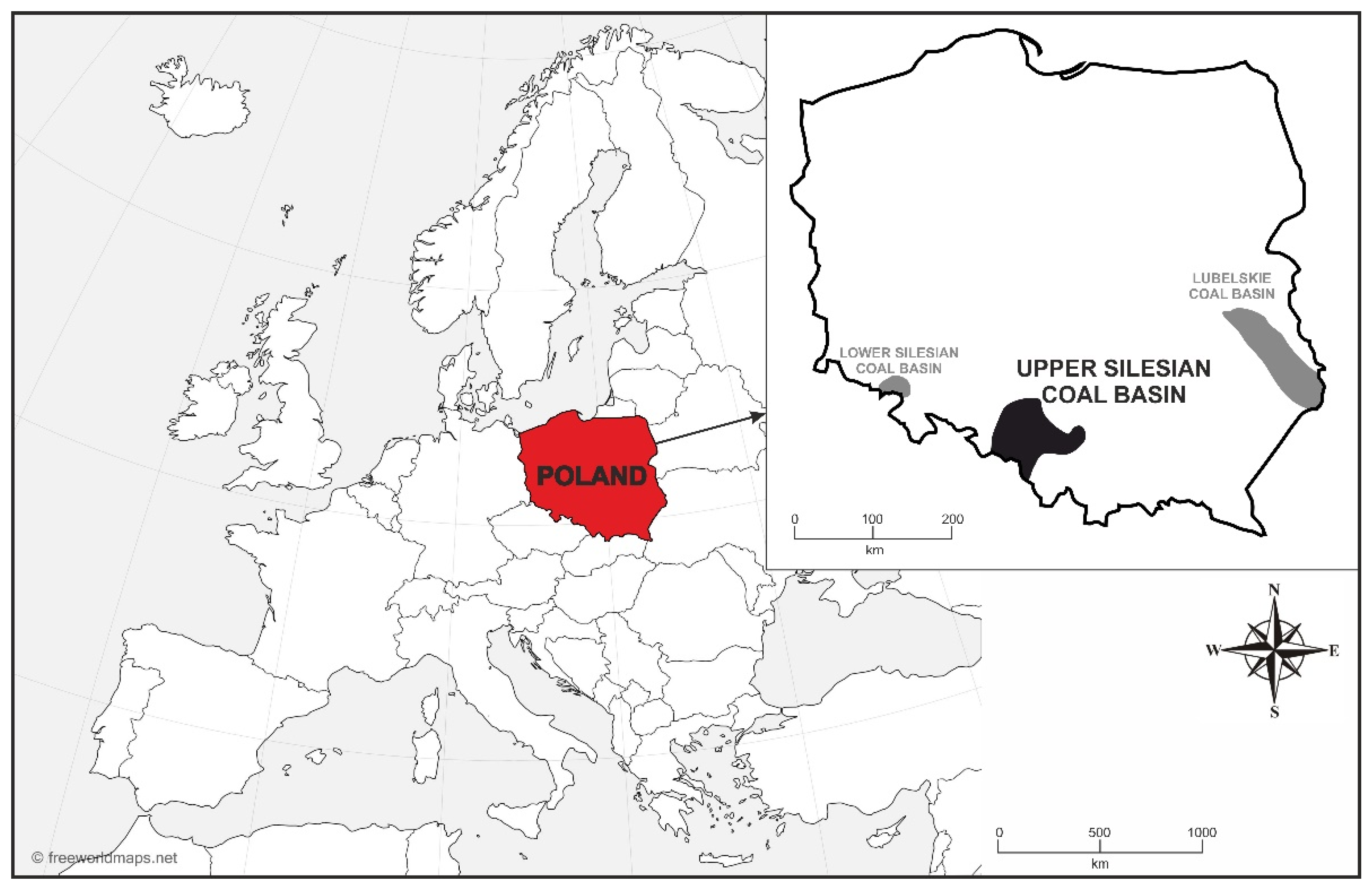
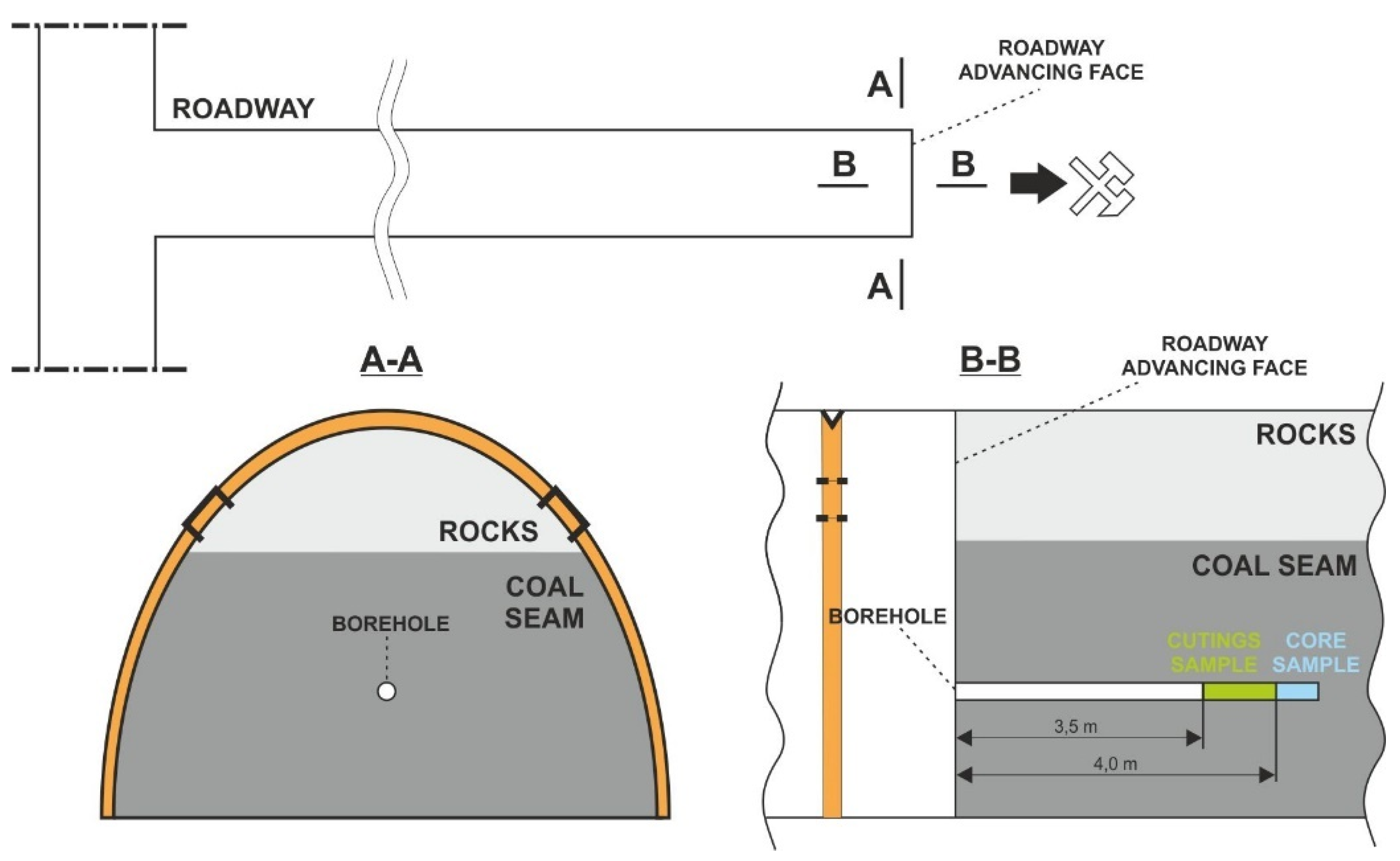
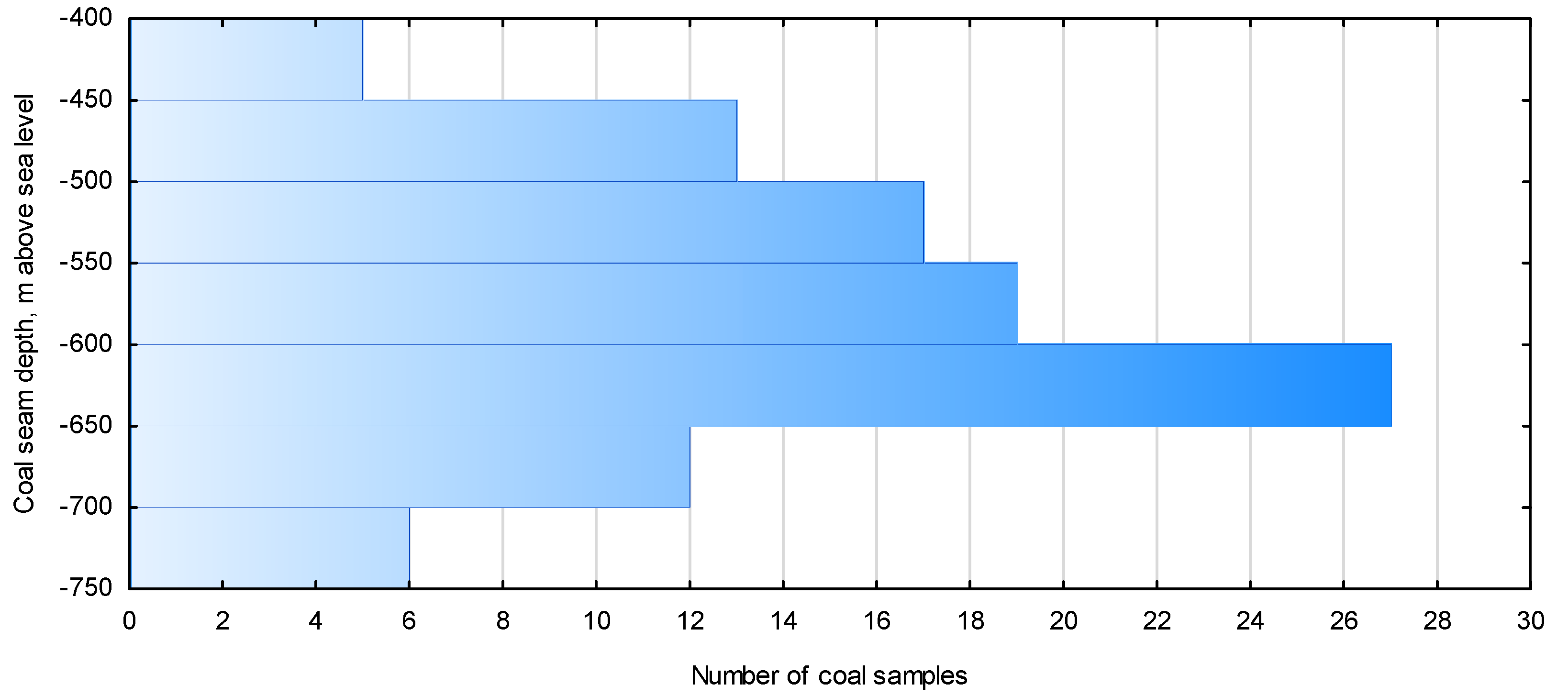
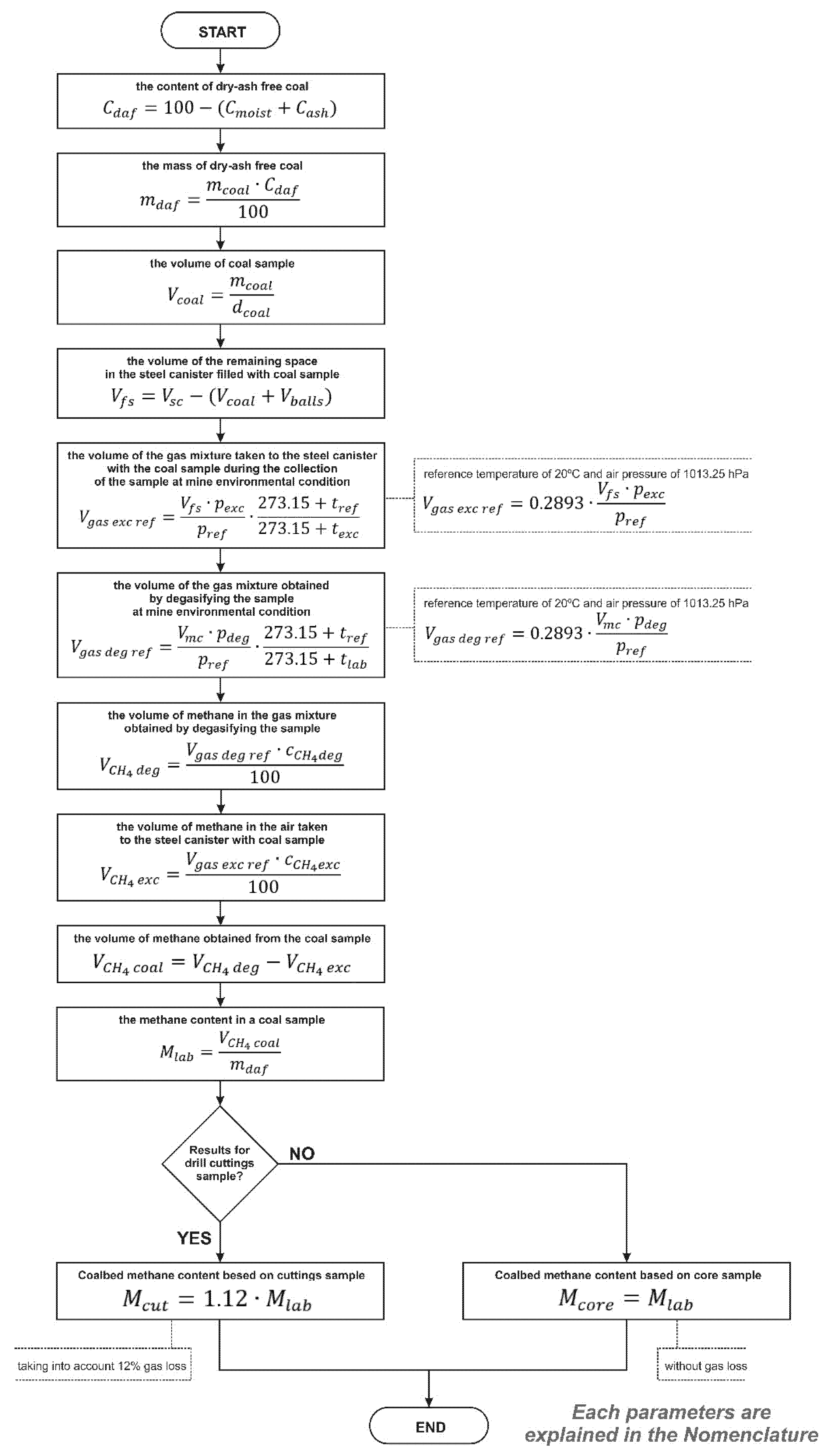


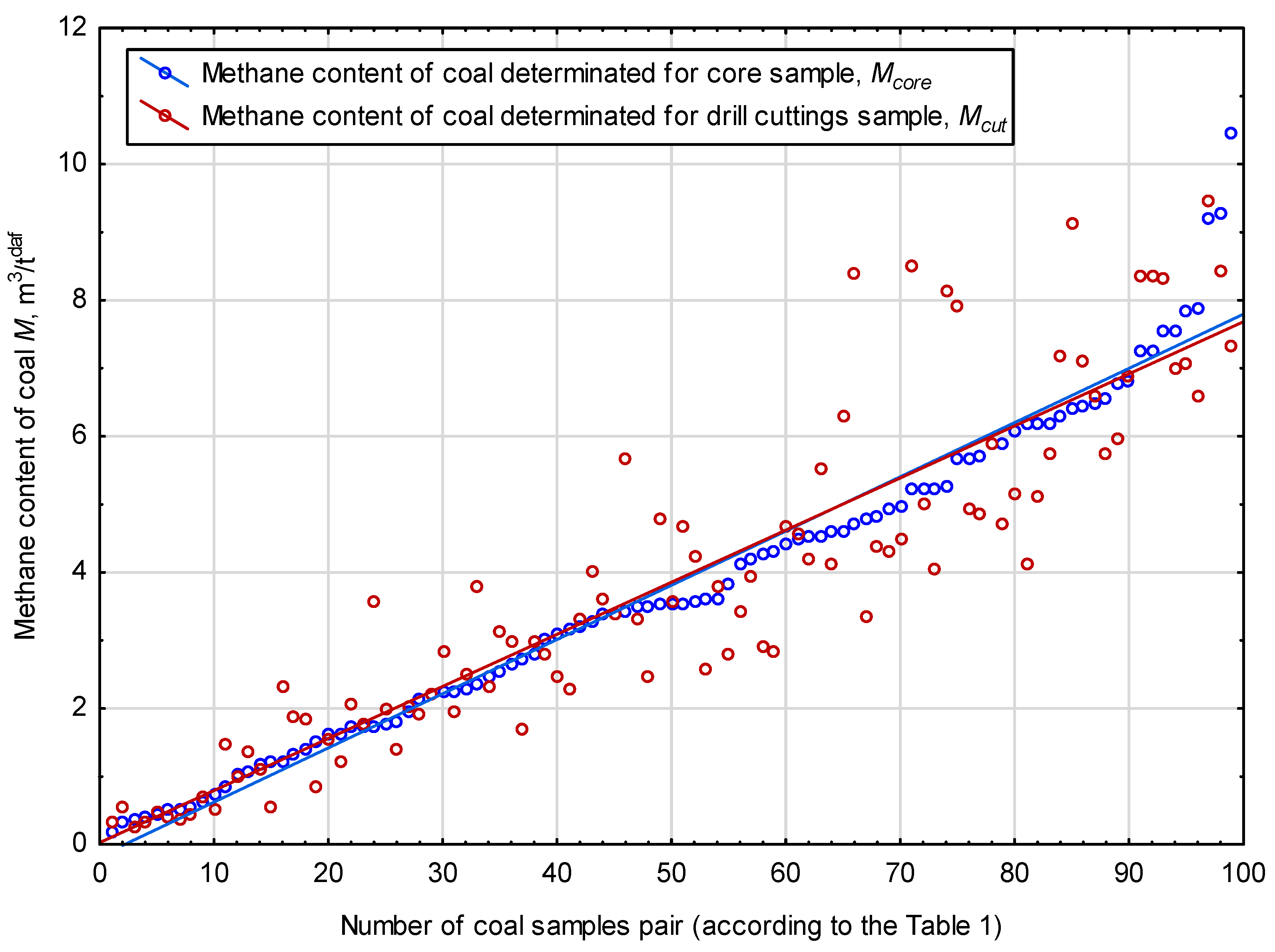
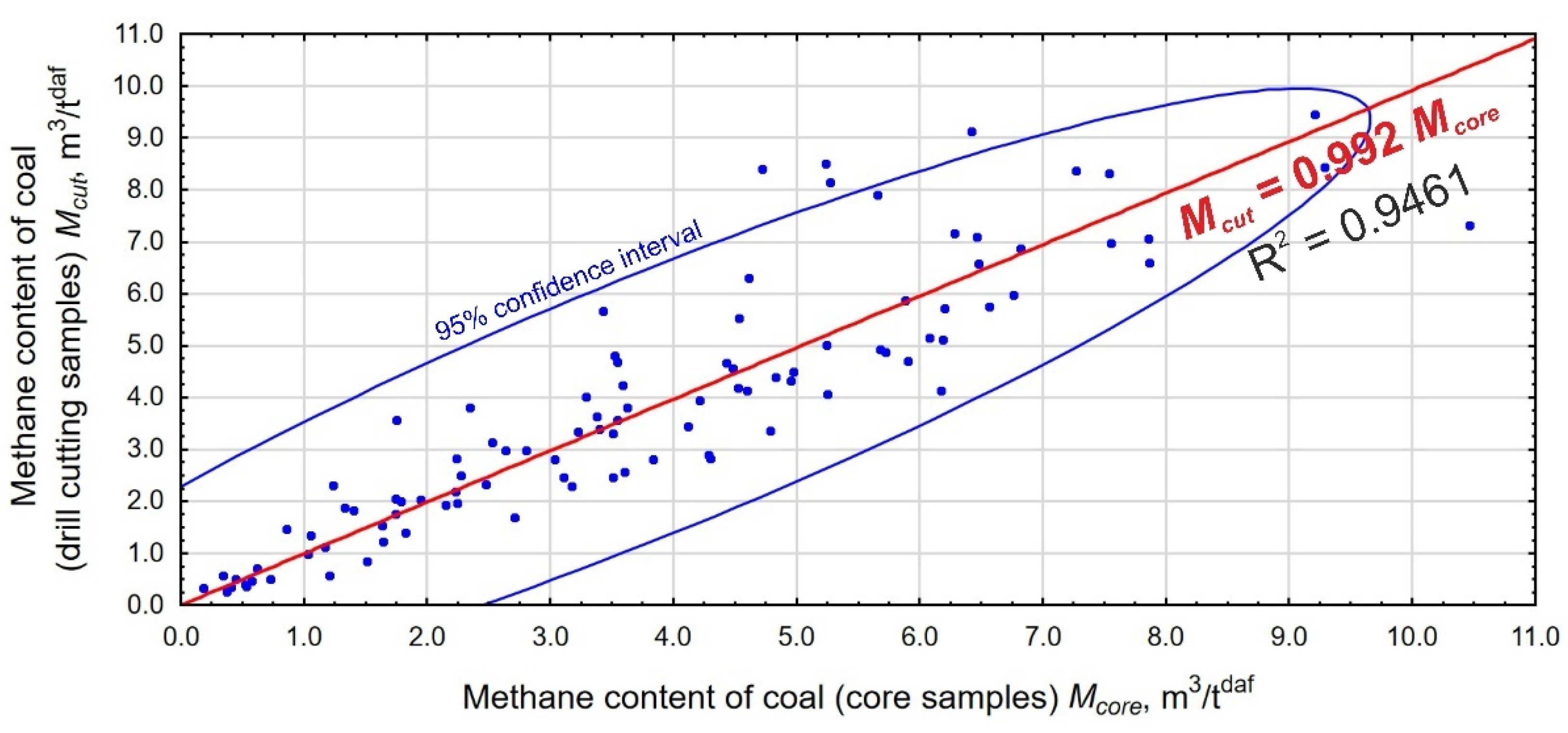
| Number of Coal Samples Pair | Coal Seam | Depth, m above Sea Level | m3/tdaf | , m3/tdaf |
|---|---|---|---|---|
| 1 | 417 | −473 | 0.184 | 0.328 |
| 2 | 417 | −448 | 0.344 | 0.561 |
| 3 | 417 | −473 | 0.369 | 0.261 |
| 4 | 417 | −481 | 0.405 | 0.349 |
| 5 | 417 | −438 | 0.442 | 0.499 |
| 6 | 417 | −425 | 0.524 | 0.395 |
| 7 | 417 | −492 | 0.533 | 0.363 |
| 8 | 417 | −461 | 0.572 | 0.463 |
| 9 | 329 | −618 | 0.615 | 0.703 |
| 10 | 417 | −513 | 0.726 | 0.505 |
| 11 | 418 | −550 | 0.857 | 1.468 |
| 12 | 418 | −516 | 1.031 | 0.982 |
| 13 | 417 | −539 | 1.056 | 1.349 |
| 14 | 409 | −708 | 1.167 | 1.114 |
| 15 | 417 | −474 | 1.208 | 0.561 |
| 16 | 406 | −611 | 1.232 | 2.315 |
| 17 | 406 | −603 | 1.327 | 1.875 |
| 18 | 329 | −492 | 1.404 | 1.837 |
| 19 | 418 | −500 | 1.512 | 0.846 |
| 20 | 417 | −673 | 1.635 | 1.541 |
| 21 | 409 | −717 | 1.639 | 1.228 |
| 22 | 409 | −602 | 1.740 | 2.055 |
| 23 | 404 | −483 | 1.742 | 1.758 |
| 24 | 409 | −701 | 1.747 | 3.572 |
| 25 | 329 | −488 | 1.784 | 2.005 |
| 26 | 410 | −628 | 1.823 | 1.396 |
| 27 | 330 | −589 | 1.946 | 2.027 |
| 28 | 409 | −690 | 2.147 | 1.932 |
| 29 | 404 | −467 | 2.228 | 2.193 |
| 30 | 416 | −614 | 2.238 | 2.824 |
| 31 | 417 | −542 | 2.242 | 1.957 |
| 32 | 329 | −415 | 2.274 | 2.498 |
| 33 | 410 | −675 | 2.346 | 3.799 |
| 34 | 410 | −602 | 2.476 | 2.333 |
| 35 | 417 | −542 | 2.528 | 3.134 |
| 36 | 410 | −578 | 2.635 | 2.981 |
| 37 | 410 | −533 | 2.708 | 1.686 |
| 38 | 417 | −699 | 2.804 | 2.977 |
| 39 | 418 | −588 | 3.035 | 2.810 |
| 40 | 410 | −522 | 3.111 | 2.471 |
| 41 | 409 | −723 | 3.173 | 2.293 |
| 42 | 404 | −533 | 3.225 | 3.334 |
| 43 | 404 | −487 | 3.289 | 4.008 |
| 44 | 409 | −630 | 3.374 | 3.627 |
| 45 | 410 | −529 | 3.401 | 3.387 |
| 46 | 415 | −637 | 3.427 | 5.674 |
| 47 | 417 | −673 | 3.509 | 3.302 |
| 48 | 417 | −653 | 3.510 | 2.456 |
| 49 | 416 | −599 | 3.521 | 4.799 |
| 50 | 409 | −632 | 3.544 | 3.567 |
| 51 | 417 | −667 | 3.545 | 4.678 |
| 52 | 410 | −673 | 3.589 | 4.235 |
| 53 | 417 | −672 | 3.601 | 2.570 |
| 54 | 417 | −675 | 3.622 | 3.809 |
| 55 | 410 | −619 | 3.834 | 2.817 |
| 56 | 418 | −552 | 4.116 | 3.439 |
| 57 | 409 | −621 | 4.212 | 3.950 |
| 58 | 410 | −617 | 4.283 | 2.897 |
| 59 | 417 | −682 | 4.300 | 2.832 |
| 60 | 404 | −490 | 4.431 | 4.668 |
| 61 | 404 | −514 | 4.480 | 4.564 |
| 62 | 404 | −508 | 4.525 | 4.188 |
| 63 | 404 | −491 | 4.529 | 5.531 |
| 64 | 417 | −684 | 4.595 | 4.138 |
| 65 | 410 | −626 | 4.614 | 6.311 |
| 66 | 406 | −616 | 4.717 | 8.402 |
| 67 | 413 | −532 | 4.788 | 3.355 |
| 68 | 410 | −605 | 4.825 | 4.388 |
| 69 | 413 | −537 | 4.953 | 4.320 |
| 70 | 416 | −614 | 4.972 | 4.492 |
| 71 | 348 | −593 | 5.233 | 8.505 |
| 72 | 406 | −588 | 5.242 | 5.018 |
| 73 | 413 | −487 | 5.248 | 4.059 |
| 74 | 348 | −643 | 5.271 | 8.144 |
| 75 | 410 | −544 | 5.654 | 7.903 |
| 76 | 404 | −489 | 5.679 | 4.928 |
| 77 | 410 | −588 | 5.724 | 4.878 |
| 78 | 409 | −720 | 5.882 | 5.882 |
| 79 | 404 | −516 | 5.905 | 4.704 |
| 80 | 405 | −596 | 6.074 | 5.159 |
| 81 | 417 | −720 | 6.173 | 4.139 |
| 82 | 416 | −598 | 6.187 | 5.118 |
| 83 | 416 | −600 | 6.202 | 5.727 |
| 84 | 410 | −581 | 6.280 | 7.165 |
| 85 | 348 | −649 | 6.418 | 9.124 |
| 86 | 410 | −635 | 6.459 | 7.090 |
| 87 | 348 | −592 | 6.477 | 6.574 |
| 88 | 406 | −617 | 6.561 | 5.755 |
| 89 | 406 | −617 | 6.763 | 5.969 |
| 90 | 406 | −611 | 6.816 | 6.874 |
| 91 | 348 | −586 | 7.271 | 8.375 |
| 92 | 348 | −590 | 7.271 | 8.375 |
| 93 | 348 | −589 | 7.533 | 8.317 |
| 94 | 406 | −616 | 7.550 | 6.984 |
| 95 | 406 | −589 | 7.860 | 7.059 |
| 96 | 406 | −617 | 7.866 | 6.604 |
| 97 | 410 | −583 | 9.209 | 9.450 |
| 98 | 406 | −623 | 9.289 | 8.439 |
| 99 | 348 | −598 | 10.460 | 7.325 |
| Parameter | Minimum | Maximum | Average | Standard Deviation |
|---|---|---|---|---|
| , m3/tdaf | 0.18 | 10.46 | 3.81 | 2.33 |
| , m3/tdaf | 0.26 | 9.45 | 3.85 | 2.43 |
| Protodyakonov coefficient of coal strength, | 0.30 | 0.96 | 0.46 | 0.18 |
| Moisture content, % | 1.25 | 9.82 | 3.33 | 1.60 |
| Ash content, % | 1.50 | 28.23 | 9.09 | 6.65 |
Publisher’s Note: MDPI stays neutral with regard to jurisdictional claims in published maps and institutional affiliations. |
© 2021 by the authors. Licensee MDPI, Basel, Switzerland. This article is an open access article distributed under the terms and conditions of the Creative Commons Attribution (CC BY) license (https://creativecommons.org/licenses/by/4.0/).
Share and Cite
Szlązak, N.; Korzec, M.; Piergies, K. The Determination of the Methane Content of Coal Seams Based on Drill Cutting and Core Samples from Coal Mine Roadway. Energies 2022, 15, 178. https://doi.org/10.3390/en15010178
Szlązak N, Korzec M, Piergies K. The Determination of the Methane Content of Coal Seams Based on Drill Cutting and Core Samples from Coal Mine Roadway. Energies. 2022; 15(1):178. https://doi.org/10.3390/en15010178
Chicago/Turabian StyleSzlązak, Nikodem, Marek Korzec, and Kazimierz Piergies. 2022. "The Determination of the Methane Content of Coal Seams Based on Drill Cutting and Core Samples from Coal Mine Roadway" Energies 15, no. 1: 178. https://doi.org/10.3390/en15010178
APA StyleSzlązak, N., Korzec, M., & Piergies, K. (2022). The Determination of the Methane Content of Coal Seams Based on Drill Cutting and Core Samples from Coal Mine Roadway. Energies, 15(1), 178. https://doi.org/10.3390/en15010178







